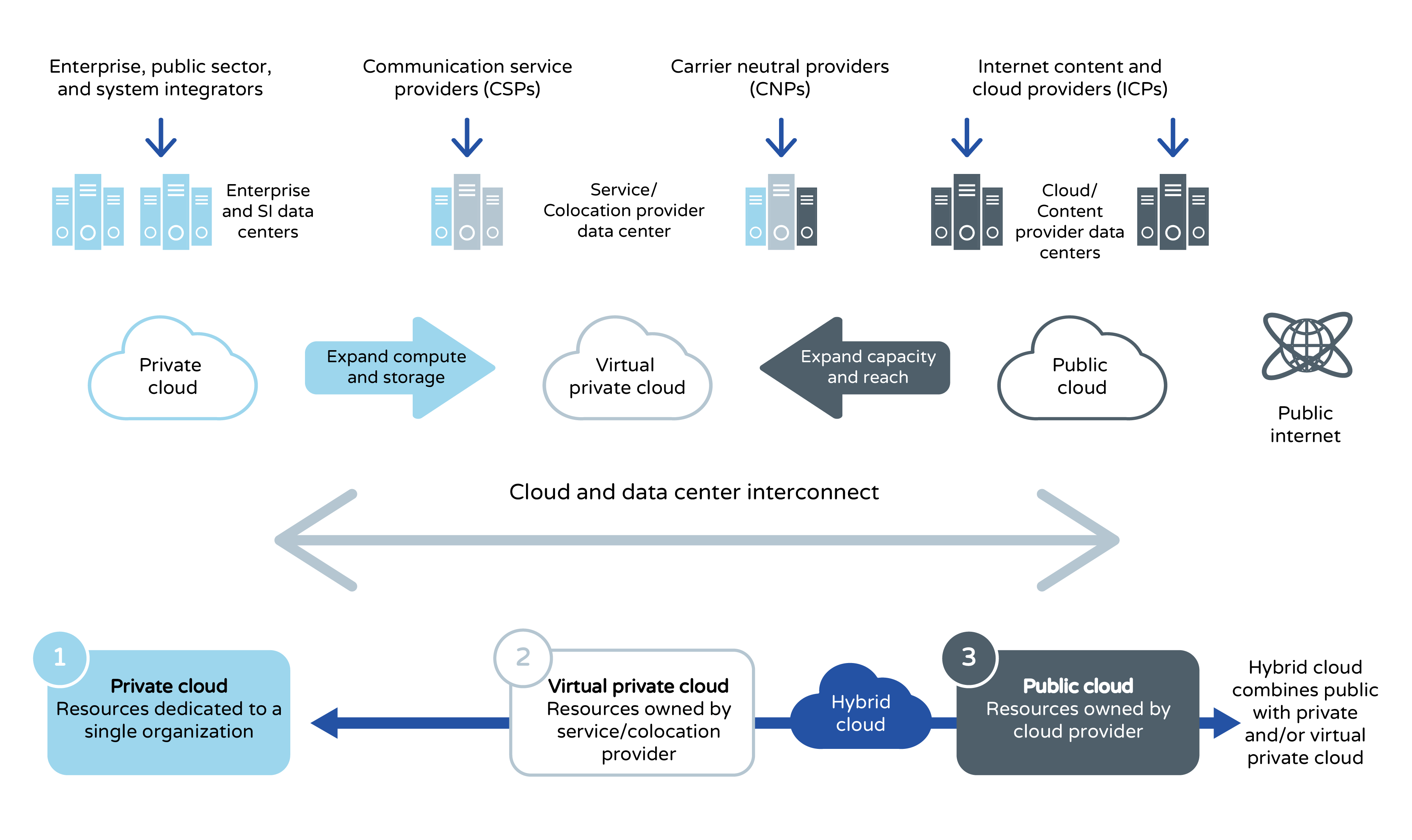A fiber connection is easy to understand; it requires a fiber, connectors at each end, and laser transceivers. Beyond these basics data center connections can become very complex. Understanding the ownership and service levels at each point can make or break a successful data center deployment:
1) Types of Data Centers and Connections
● Cloud Data Centers and Hosted Data Centers – They offer services that include compute, power and bandwidth – all bundled into a neat monthly recurring fee or consumption-based pricing model. The data center manages all fiber optic connections from the rack to the carrier demarcation point. This service gives customers a direct fiber connection to their cloud service provider and eliminates the need for data to travel across public links between the customer and the cloud provider.
● Owned Data Centers – Companies that own and operate their own data center are responsible for all management of fiber optic connections. Campus cross-connects are a physical link between servers, routers, switches or other equipment. However, instead of existing within one building, the connection is made between two geographically separate buildings. Data Center Interconnect is the connection between two or more geographically dispersed data centers provided by a carrier or via leased or owned fiber by the data center.
● Colocation Data Centers– They offer a wide variety of services that begin with floor space, power and bandwidth. Plus, they leverage multiple tenants under one roof to maximize the significant resources required to effectively operate a data center. Fiber optic connections in colocation data centers are more complex, as the data center may manage physical fiber level ‘Cross-Connects” between a tenant and a carrier or a tenant and another tenant. This underscores the importance of making the correct choices for fiber optic connectivity.
Colocation data centers can be carrier neutral, or carrier owned. Carrier neutrals have physical fiber connections with two or more “On-net” service providers. In addition, other third-party service providers may bring fiber to the data center to service customers. This differs from a data center which is served exclusively by one service provider.
● Carrier Hotel - A carrier hotel is not a data center. It is a building with fiber connections to many service providers where inter connection between two or more providers can be created.

2) Fiber Ownership
Who owns or leases the fiber is an important distinction. The primary fiber providers include the following organizations:
● Service Providers - These are the telecommunications or cable companies e.g. Deutch Telecom, NTT, Tata, Verizon or Comcast.
● Dark Fiber Providers - Some organizations such as eunetworks, Zayo, Crown and Castle, lease fiber to others. Leases are called Indefeasible Right of Use (IRU) and grant the lessor exclusive right to the fiber.
● Internet Content Providers - Increasingly organizations like Microsoft, Facebook, Google, Akami, or Alibaba will build their own fiber infrastructure to support content collection, analysis and distribution.
3) Technical Specifications
There are a wide variety of technical parameters required for these connections. Fiber connections are usually agnostic to the upper layer protocols that traverse the connection, but they are typically specified and may even define the connection type. A partial list of specifications that may be required includes:
1. Type, length, or loss of fiber
2. Data rate
3. Transceiver (e.g. coherent, PAM)
4. Connector
5. Wavelength
6. Other cables (AOC, DOC)
7. Layer 2 service
8. Layer 3 service
There are often a number of transceiver options for each connection type. AddOn specializes in helping customers understand the trade-offs. The most common transceivers for data center links are the SFP, SFP+ and QSFP+ form factors, these typically connect over longer distances. The reach, data rate, connector type, wavelength and operating temperature will be relevant to making the optimal selection.
Fiber connections within the data center may present the broadest array of options for both transceivers and the AOC/DAC cables used to create efficient fiber architectures within the building. No matter what your connection type, AddOn offers both the expertise and inventory to provide the optimal solution for your needs.
